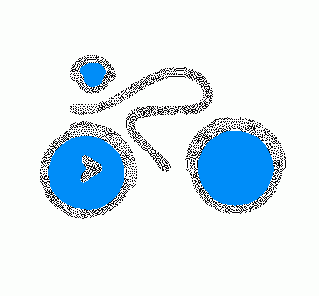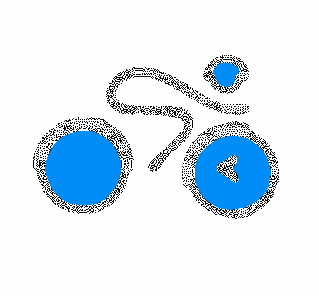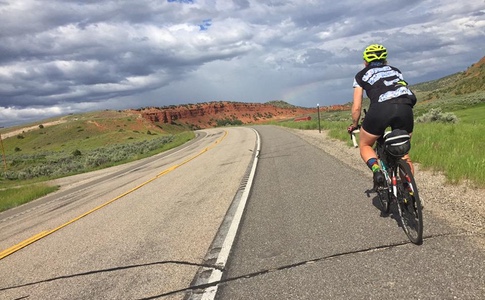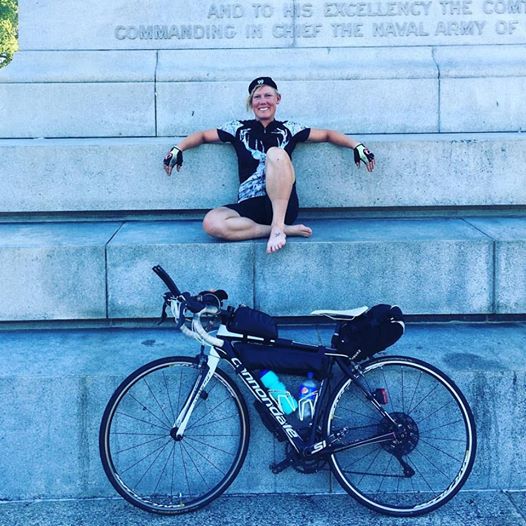| Newsletter - 2017 Archive |
 |
Cycling Club |
 |
| Newsletter - 2017 Archive |
 |
Cycling Club |
 |
Next--->

Across America: the Trans Am Bike Race Meaghan Hackinen is a former BC resident currently living in Saskatoon, SK. She rides with the Prairie Randonneurs. How do you put a 6,800-kilometre bike ride into words? It isn't easy. Harder still when the journey itself remains a blur, time spent sleep deprived, half-starved, body committed to cadence and navigating curves at the expense of brainpower. Over a month post-race and I struggle to pin down anything succinctly. It was emotional. Astoria, Oregon: I rolled out alongside 130 other riders in the 4th annual grand depart of the Trans Am Bike Race at 0600 hours on June 3rd, 2017. I'd been dreaming/dreading this day since receiving my registration confirmation in December, the same day I went out and purchased frame bags and a one-way ticket to Portland. Now, the morning had arrived. Decked out in a highlighter-yellow rain jacket and matching helmet (purchased on arrival to replace my own helmet that had been forgotten in pre-flight packing haste) I raised a plastic goblet of champagne poured by race vet and legendary lanterne rouge Thomas Camero to cheers to my fellow competitors. Race organizer Nathan Jones reiterated final reminders and advice - "Remember: rubber-side down" - before we counted down to the start clock. The first five miles until the bridge everyone rides together. After that, you're on your own. The Trans Am Bike Race is a 6,800 kilometre self-supported road race taking riders from coast to coast along the American Cycling Association's oldest bike route: the TransAmerica Trail. Racers cross ten states with wildly diverse terrain, from the West Coast to the Rocky Mountains, Great Plains, Ozarks and Appalachians—with the winners finishing in 17 or 18 days. Similar to the spirit of randonneuring, racers are self-sufficient and responsible for the procurement of nourishment, accommodations, and bike maintenance. Unlike randonneuring, drafting is not permissible (unless you register as a pair) and there are no controls: you start in Astoria, Oregon, finish at Yorktown Monument in Virginia, and rely on the thin red line of a GPS as your guide across the country. Racers can only access unilateral support available to other competitors (hotels, restaurants, campgrounds, etc.) but may accept unsolicited assistance from trail angels and kind-hearted strangers. As well, racers are equipped with trackers and that display their positions online for friends, competitors, and dot watchers to follow. So I rode. I rode my bike every day for 24 days and 22 hours. I rode at all hours, slept around four hours each night, and snagged catnaps in shady corners during sweltering afternoons. I devoured microwave breakfast sandwiches and bags of sugar-coated candy at gas stations, clubhouses at small-town diners, and midnight breakfasts at McDonalds' drive-thrus. I slept on picnic tables and in city parks and motels where staff would leave a key under the doormat for after-hours check-in. I wore the same pair of kit every single day and washed it in the shower. I biked in rain and sleet and snow and wheat-dust clouds in Kansas. I laughed more than I cried and didn't take enough photos. I wish I could tell you the story of an intrepid female cyclist who conquered the road alone, but that wouldn't be true. Climbing out of White Bird in Idaho on the morning of day five I met another racer, a guy named Matthias from Germany with razor-sharp tan lines and a quiet determination. I didn't expect to keep riding with Matthias, it just worked out that way. "I only find you slightly annoying," he said to me, somewhere in Wyoming. Matthias and I teamed up with other racers a few times, once for a stretch with a rider from Switzerland named Rolf when the weather turned on us outside of Yellowstone Park. Faced with formidable headwinds, the three of us called it a day in the early afternoon and grabbed the last room at a motel in Ennis. We crammed down pizza and pints of beer while waiting for our clothes to dry at the neighbouring laundromat, hit the hay by 6:00 pm, then set out again before midnight to reach West Yellowstone in time for breakfast. During the second half of the race my own sluggishness and inability to cover as much distance as anticipated became major sources of frustration. I watched my speed drop day by day until it dwindled below 20 kilometres an hour, at which point I nudged the magnet of my computer out of place so that I wouldn't see my snail's pace in numerical form—it was depressing. Once a gas station attendant in Eastern Colorado asked if we'd been getting passed by a lot of racers; I didn't have it in me to clarify that we were racers. Hours in the saddle took a toll on my body and lack of sleep, combined with a nutrient-poor diet, made recovery near impossible. I was losing finger strength from nerve damage in my left hand and could no longer manage more than a few minutes without adjusting my saddle position. By day five, when I met Matthias, my right Achilles had begun to show signs of inflammation. I immediately lowered my seat and adjusted the cleat placement, but spent the remainder of the race bouncing between happy Achilles (low seat) and happy knees (high seat). By the time I hit the rolling hills of Virginia, I'd carved a morning routine that included a copious application of chamois cream, KT-tape to immobilize my swollen Achilles, and vitamin-A (Advil) washed down with a 5-hour energy drink. >Yet while my body appeared to be disintegrating before my eyes, the sinew that held everything together remained strong. I came to exist in a state of fatigued awe, startled yet amazed by my own existence and the prospect of another consecutive near-300-kilometre day in the saddle. There was no longer any doubt in my mind that I was actually doing this, wheels tracking east as each pedal stroke brought me closer to the Atlantic. Near Leoti, Kansas, a fellow racer named Eric Fishbein was struck and killed by a motor vehicle. Eric was 61 with a Boston accent that cut through a crowd and a contagious sense of adventure. I was jarred by news of his death: Eric and I had stayed at the same Warm Showers host in Astoria and paired up to search out lithium batteries for our Spot trackers and get barbershop haircuts while sharing pre-race anxieties. We rode to the start, side by side, and I'd imagined swapping stories with him at the finish line. I pushed on toward Yorktown with Eric in my thoughts, imagining what he'd have to say about the journey—the endless rollers of Missouri or the great muddy expanse of the Mississippi—if he'd witnessed the remainder with his own eyes. I wish my deepest condolences to Eric's family and friends, and am grateful our paths crossed. Aside from the firsts—first day, first flat, first mountain pass—and the final 24-hour push to the finish, what I remember most about the Trans Am are the transitional moments. The time between night and sunrise when darkness pales to indigo and finally melts away to streamers of pink and orange; the buggy hour around sunset when fireflies begin to wink and you ride closed-mouthed, glasses pressed tight to bridge of nose to keep the mosquitoes out; the dragging minutes on the outskirts of town as you pull closer to your nighttime destination, street lamps humming atomic tangerine and mailboxes perched close together. These unremarkable glimpses of America are what remain stuck to me. Ingrained into the backs of my retinas. The makings of a scrapbook from photos I didn't take, yet able to conjure the road-worn ache of fleeting adventure in briefest blink of an eye.  Meaghan at the finish - Yorktown Victory Monument, Yorktown, Virginia
- September 14, 2017 |